Toyota's Lean Management Strategy: Continuous Improvement Proposal
VerifiedAdded on 2023/04/22
|8
|1340
|442
Report
AI Summary
This report provides an analysis of Toyota's application of lean management principles, emphasizing the company's commitment to minimizing waste and maximizing customer value. It explores the five key principles of lean management and critically evaluates Toyota's processes, detailing the development of a target process and an implementation plan. The report also proposes a strategy for instituting continuous improvement within Toyota's operations, aligning lean principles with ongoing efforts to enhance product and service quality. The analysis highlights Toyota's success in integrating lean thinking into its organizational culture, driving efficiency and customer satisfaction. This student-contributed report is available on Desklib, where you can find a wealth of academic resources.

Running head: MANAGEMENT
Management
Name of the Student
Name of the University
Author note
Management
Name of the Student
Name of the University
Author note
Paraphrase This Document
Need a fresh take? Get an instant paraphrase of this document with our AI Paraphraser
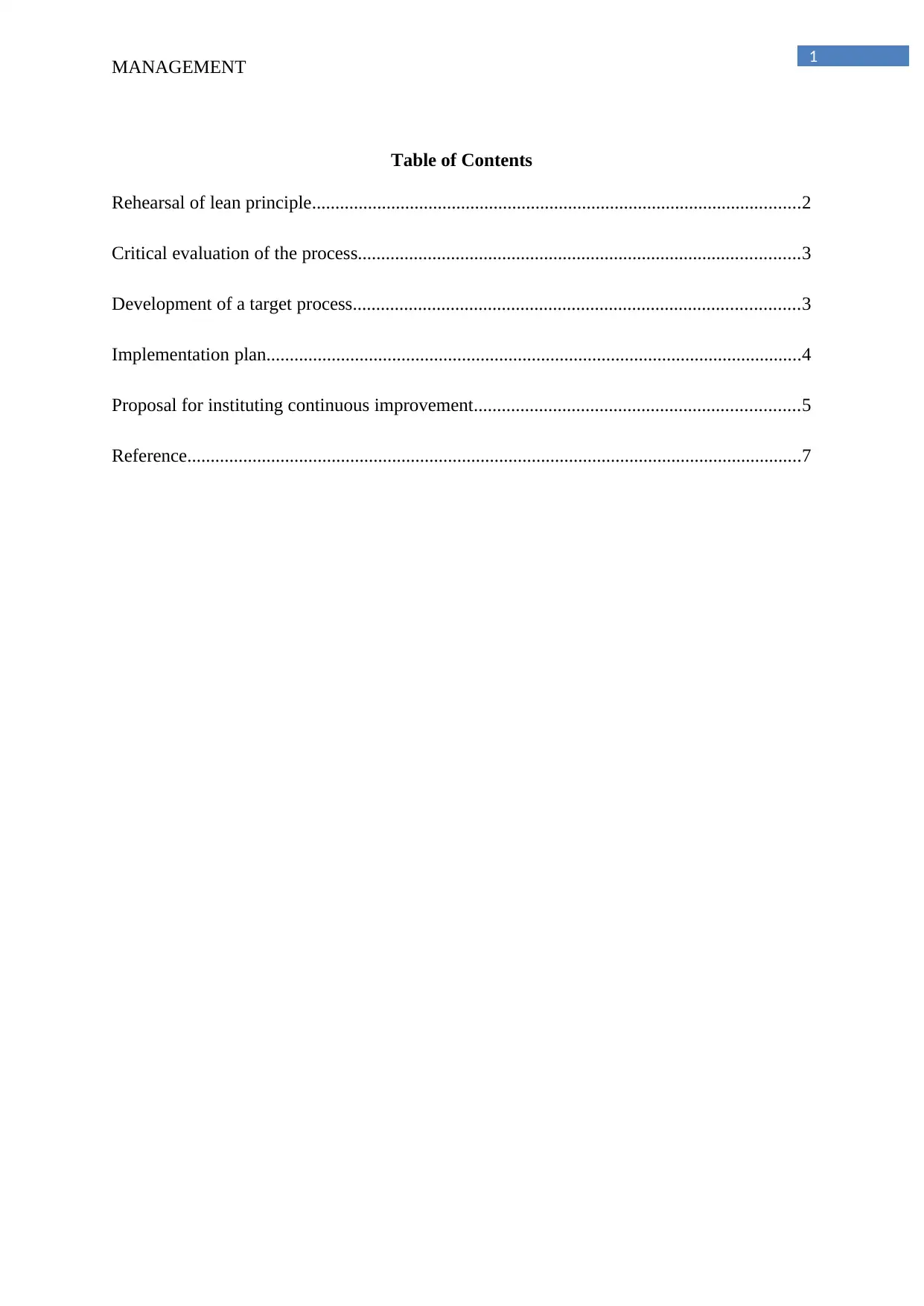
1
MANAGEMENT
Table of Contents
Rehearsal of lean principle.........................................................................................................2
Critical evaluation of the process...............................................................................................3
Development of a target process................................................................................................3
Implementation plan...................................................................................................................4
Proposal for instituting continuous improvement......................................................................5
Reference....................................................................................................................................7
MANAGEMENT
Table of Contents
Rehearsal of lean principle.........................................................................................................2
Critical evaluation of the process...............................................................................................3
Development of a target process................................................................................................3
Implementation plan...................................................................................................................4
Proposal for instituting continuous improvement......................................................................5
Reference....................................................................................................................................7
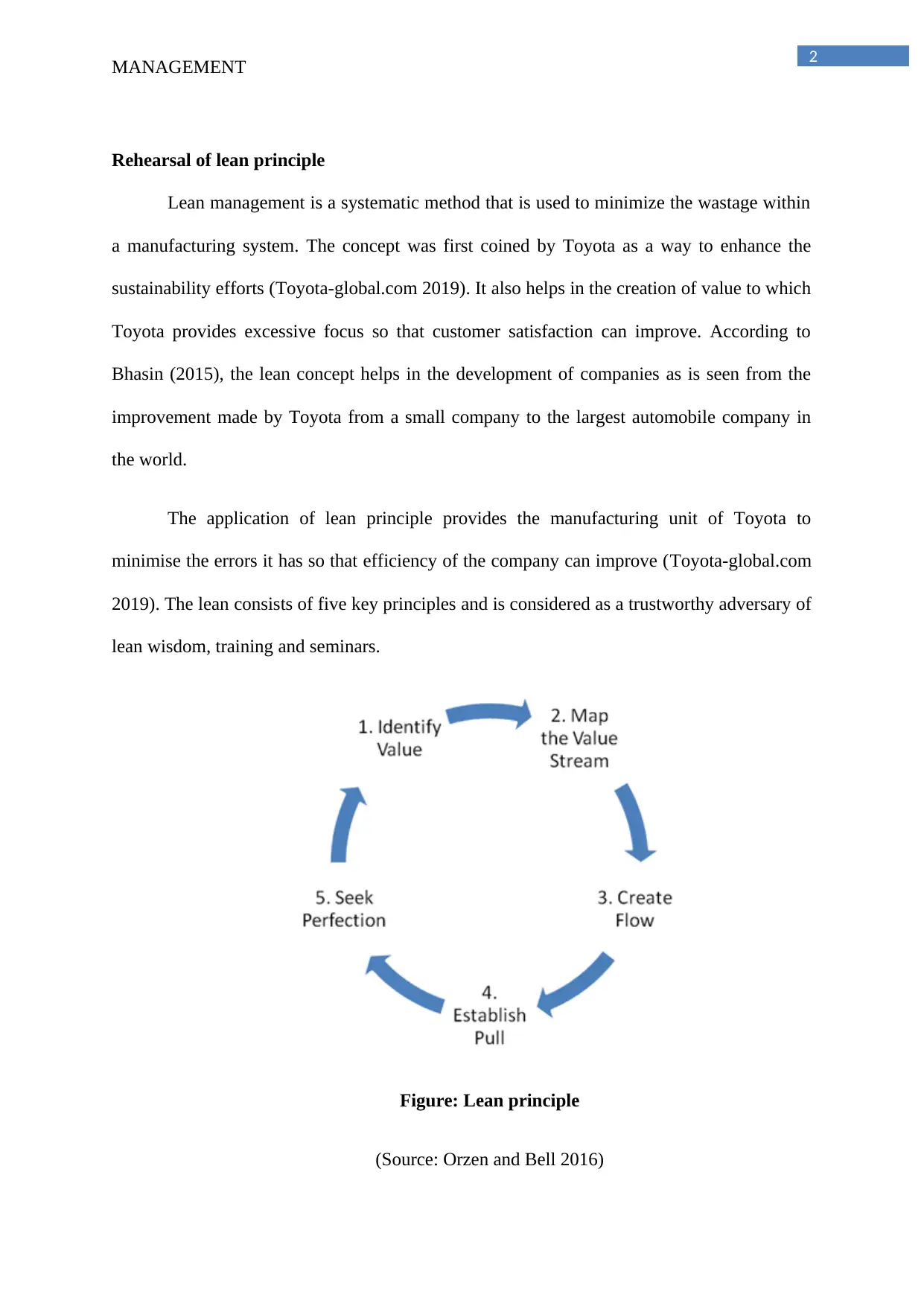
2
MANAGEMENT
Rehearsal of lean principle
Lean management is a systematic method that is used to minimize the wastage within
a manufacturing system. The concept was first coined by Toyota as a way to enhance the
sustainability efforts (Toyota-global.com 2019). It also helps in the creation of value to which
Toyota provides excessive focus so that customer satisfaction can improve. According to
Bhasin (2015), the lean concept helps in the development of companies as is seen from the
improvement made by Toyota from a small company to the largest automobile company in
the world.
The application of lean principle provides the manufacturing unit of Toyota to
minimise the errors it has so that efficiency of the company can improve (Toyota-global.com
2019). The lean consists of five key principles and is considered as a trustworthy adversary of
lean wisdom, training and seminars.
Figure: Lean principle
(Source: Orzen and Bell 2016)
MANAGEMENT
Rehearsal of lean principle
Lean management is a systematic method that is used to minimize the wastage within
a manufacturing system. The concept was first coined by Toyota as a way to enhance the
sustainability efforts (Toyota-global.com 2019). It also helps in the creation of value to which
Toyota provides excessive focus so that customer satisfaction can improve. According to
Bhasin (2015), the lean concept helps in the development of companies as is seen from the
improvement made by Toyota from a small company to the largest automobile company in
the world.
The application of lean principle provides the manufacturing unit of Toyota to
minimise the errors it has so that efficiency of the company can improve (Toyota-global.com
2019). The lean consists of five key principles and is considered as a trustworthy adversary of
lean wisdom, training and seminars.
Figure: Lean principle
(Source: Orzen and Bell 2016)
⊘ This is a preview!⊘
Do you want full access?
Subscribe today to unlock all pages.

Trusted by 1+ million students worldwide
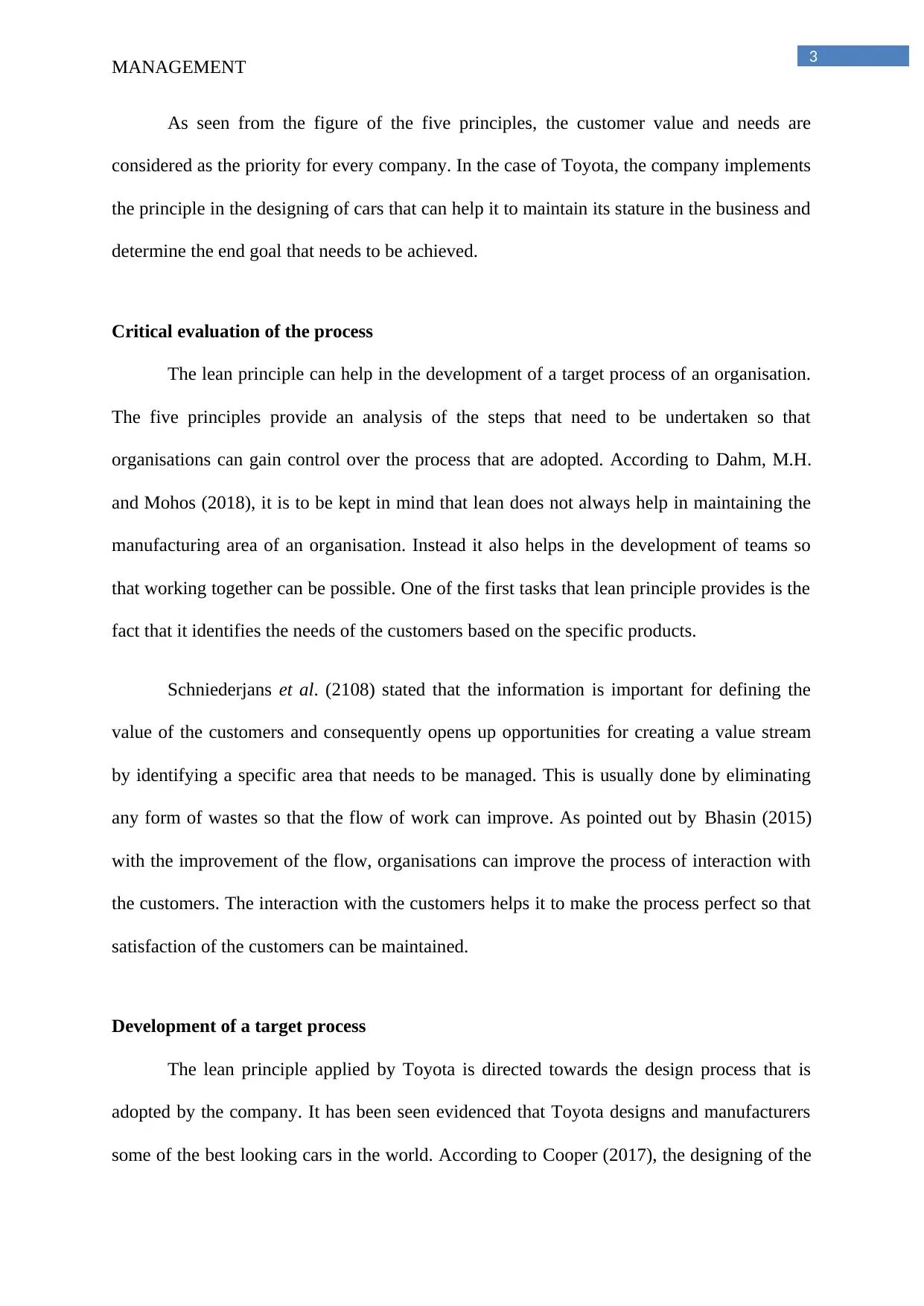
3
MANAGEMENT
As seen from the figure of the five principles, the customer value and needs are
considered as the priority for every company. In the case of Toyota, the company implements
the principle in the designing of cars that can help it to maintain its stature in the business and
determine the end goal that needs to be achieved.
Critical evaluation of the process
The lean principle can help in the development of a target process of an organisation.
The five principles provide an analysis of the steps that need to be undertaken so that
organisations can gain control over the process that are adopted. According to Dahm, M.H.
and Mohos (2018), it is to be kept in mind that lean does not always help in maintaining the
manufacturing area of an organisation. Instead it also helps in the development of teams so
that working together can be possible. One of the first tasks that lean principle provides is the
fact that it identifies the needs of the customers based on the specific products.
Schniederjans et al. (2108) stated that the information is important for defining the
value of the customers and consequently opens up opportunities for creating a value stream
by identifying a specific area that needs to be managed. This is usually done by eliminating
any form of wastes so that the flow of work can improve. As pointed out by Bhasin (2015)
with the improvement of the flow, organisations can improve the process of interaction with
the customers. The interaction with the customers helps it to make the process perfect so that
satisfaction of the customers can be maintained.
Development of a target process
The lean principle applied by Toyota is directed towards the design process that is
adopted by the company. It has been seen evidenced that Toyota designs and manufacturers
some of the best looking cars in the world. According to Cooper (2017), the designing of the
MANAGEMENT
As seen from the figure of the five principles, the customer value and needs are
considered as the priority for every company. In the case of Toyota, the company implements
the principle in the designing of cars that can help it to maintain its stature in the business and
determine the end goal that needs to be achieved.
Critical evaluation of the process
The lean principle can help in the development of a target process of an organisation.
The five principles provide an analysis of the steps that need to be undertaken so that
organisations can gain control over the process that are adopted. According to Dahm, M.H.
and Mohos (2018), it is to be kept in mind that lean does not always help in maintaining the
manufacturing area of an organisation. Instead it also helps in the development of teams so
that working together can be possible. One of the first tasks that lean principle provides is the
fact that it identifies the needs of the customers based on the specific products.
Schniederjans et al. (2108) stated that the information is important for defining the
value of the customers and consequently opens up opportunities for creating a value stream
by identifying a specific area that needs to be managed. This is usually done by eliminating
any form of wastes so that the flow of work can improve. As pointed out by Bhasin (2015)
with the improvement of the flow, organisations can improve the process of interaction with
the customers. The interaction with the customers helps it to make the process perfect so that
satisfaction of the customers can be maintained.
Development of a target process
The lean principle applied by Toyota is directed towards the design process that is
adopted by the company. It has been seen evidenced that Toyota designs and manufacturers
some of the best looking cars in the world. According to Cooper (2017), the designing of the
Paraphrase This Document
Need a fresh take? Get an instant paraphrase of this document with our AI Paraphraser
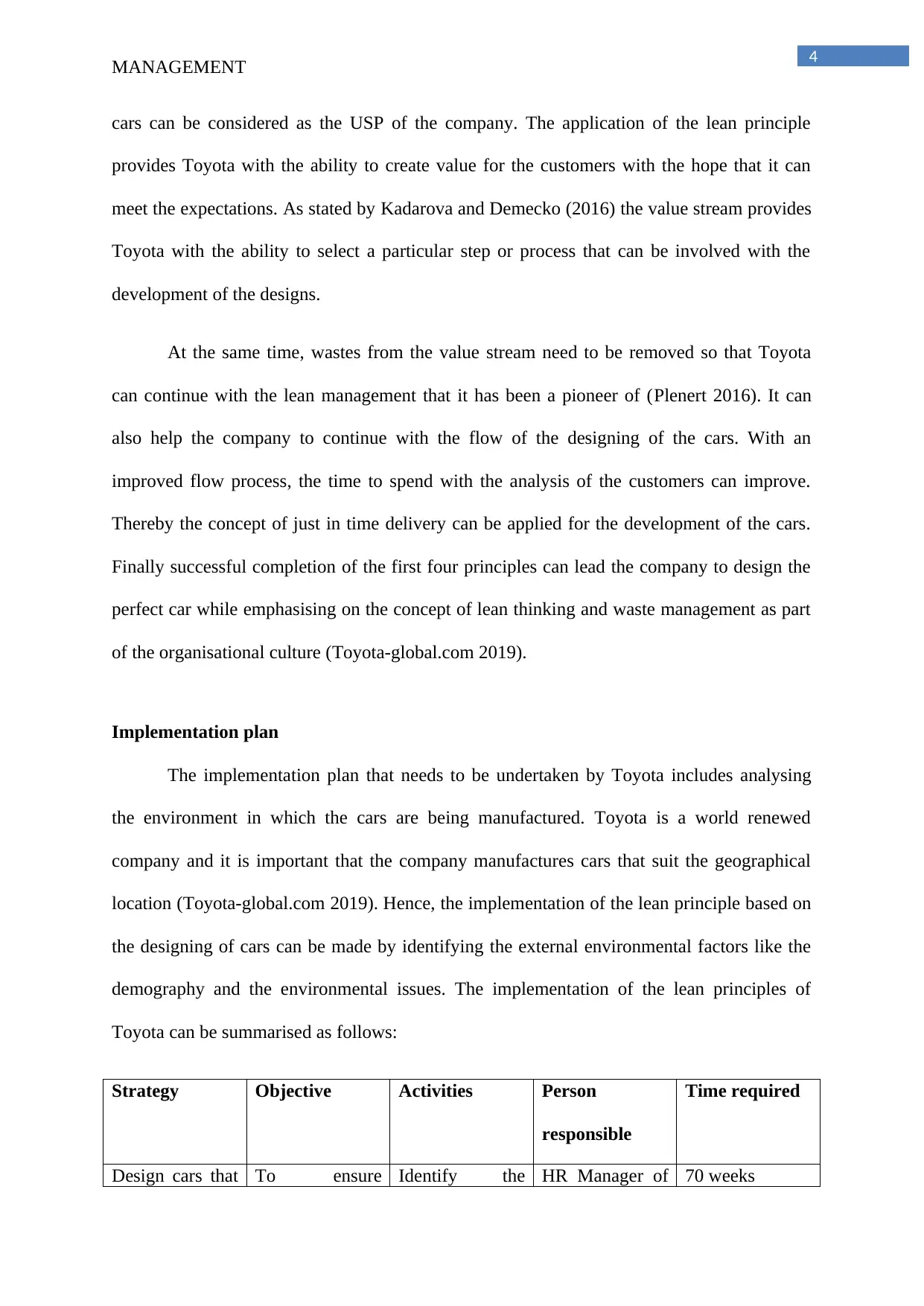
4
MANAGEMENT
cars can be considered as the USP of the company. The application of the lean principle
provides Toyota with the ability to create value for the customers with the hope that it can
meet the expectations. As stated by Kadarova and Demecko (2016) the value stream provides
Toyota with the ability to select a particular step or process that can be involved with the
development of the designs.
At the same time, wastes from the value stream need to be removed so that Toyota
can continue with the lean management that it has been a pioneer of (Plenert 2016). It can
also help the company to continue with the flow of the designing of the cars. With an
improved flow process, the time to spend with the analysis of the customers can improve.
Thereby the concept of just in time delivery can be applied for the development of the cars.
Finally successful completion of the first four principles can lead the company to design the
perfect car while emphasising on the concept of lean thinking and waste management as part
of the organisational culture (Toyota-global.com 2019).
Implementation plan
The implementation plan that needs to be undertaken by Toyota includes analysing
the environment in which the cars are being manufactured. Toyota is a world renewed
company and it is important that the company manufactures cars that suit the geographical
location (Toyota-global.com 2019). Hence, the implementation of the lean principle based on
the designing of cars can be made by identifying the external environmental factors like the
demography and the environmental issues. The implementation of the lean principles of
Toyota can be summarised as follows:
Strategy Objective Activities Person
responsible
Time required
Design cars that To ensure Identify the HR Manager of 70 weeks
MANAGEMENT
cars can be considered as the USP of the company. The application of the lean principle
provides Toyota with the ability to create value for the customers with the hope that it can
meet the expectations. As stated by Kadarova and Demecko (2016) the value stream provides
Toyota with the ability to select a particular step or process that can be involved with the
development of the designs.
At the same time, wastes from the value stream need to be removed so that Toyota
can continue with the lean management that it has been a pioneer of (Plenert 2016). It can
also help the company to continue with the flow of the designing of the cars. With an
improved flow process, the time to spend with the analysis of the customers can improve.
Thereby the concept of just in time delivery can be applied for the development of the cars.
Finally successful completion of the first four principles can lead the company to design the
perfect car while emphasising on the concept of lean thinking and waste management as part
of the organisational culture (Toyota-global.com 2019).
Implementation plan
The implementation plan that needs to be undertaken by Toyota includes analysing
the environment in which the cars are being manufactured. Toyota is a world renewed
company and it is important that the company manufactures cars that suit the geographical
location (Toyota-global.com 2019). Hence, the implementation of the lean principle based on
the designing of cars can be made by identifying the external environmental factors like the
demography and the environmental issues. The implementation of the lean principles of
Toyota can be summarised as follows:
Strategy Objective Activities Person
responsible
Time required
Design cars that To ensure Identify the HR Manager of 70 weeks
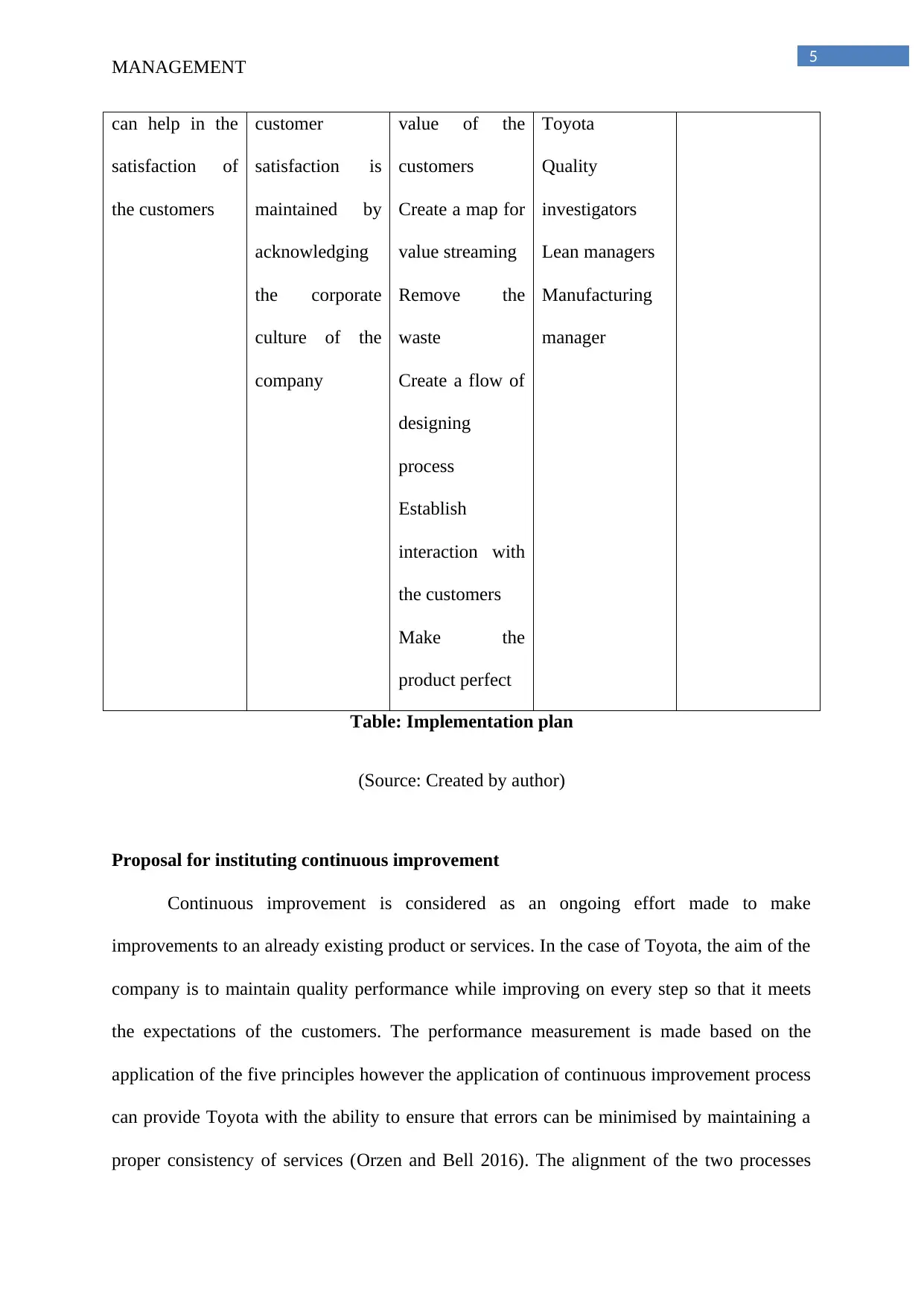
5
MANAGEMENT
can help in the
satisfaction of
the customers
customer
satisfaction is
maintained by
acknowledging
the corporate
culture of the
company
value of the
customers
Create a map for
value streaming
Remove the
waste
Create a flow of
designing
process
Establish
interaction with
the customers
Make the
product perfect
Toyota
Quality
investigators
Lean managers
Manufacturing
manager
Table: Implementation plan
(Source: Created by author)
Proposal for instituting continuous improvement
Continuous improvement is considered as an ongoing effort made to make
improvements to an already existing product or services. In the case of Toyota, the aim of the
company is to maintain quality performance while improving on every step so that it meets
the expectations of the customers. The performance measurement is made based on the
application of the five principles however the application of continuous improvement process
can provide Toyota with the ability to ensure that errors can be minimised by maintaining a
proper consistency of services (Orzen and Bell 2016). The alignment of the two processes
MANAGEMENT
can help in the
satisfaction of
the customers
customer
satisfaction is
maintained by
acknowledging
the corporate
culture of the
company
value of the
customers
Create a map for
value streaming
Remove the
waste
Create a flow of
designing
process
Establish
interaction with
the customers
Make the
product perfect
Toyota
Quality
investigators
Lean managers
Manufacturing
manager
Table: Implementation plan
(Source: Created by author)
Proposal for instituting continuous improvement
Continuous improvement is considered as an ongoing effort made to make
improvements to an already existing product or services. In the case of Toyota, the aim of the
company is to maintain quality performance while improving on every step so that it meets
the expectations of the customers. The performance measurement is made based on the
application of the five principles however the application of continuous improvement process
can provide Toyota with the ability to ensure that errors can be minimised by maintaining a
proper consistency of services (Orzen and Bell 2016). The alignment of the two processes
⊘ This is a preview!⊘
Do you want full access?
Subscribe today to unlock all pages.

Trusted by 1+ million students worldwide
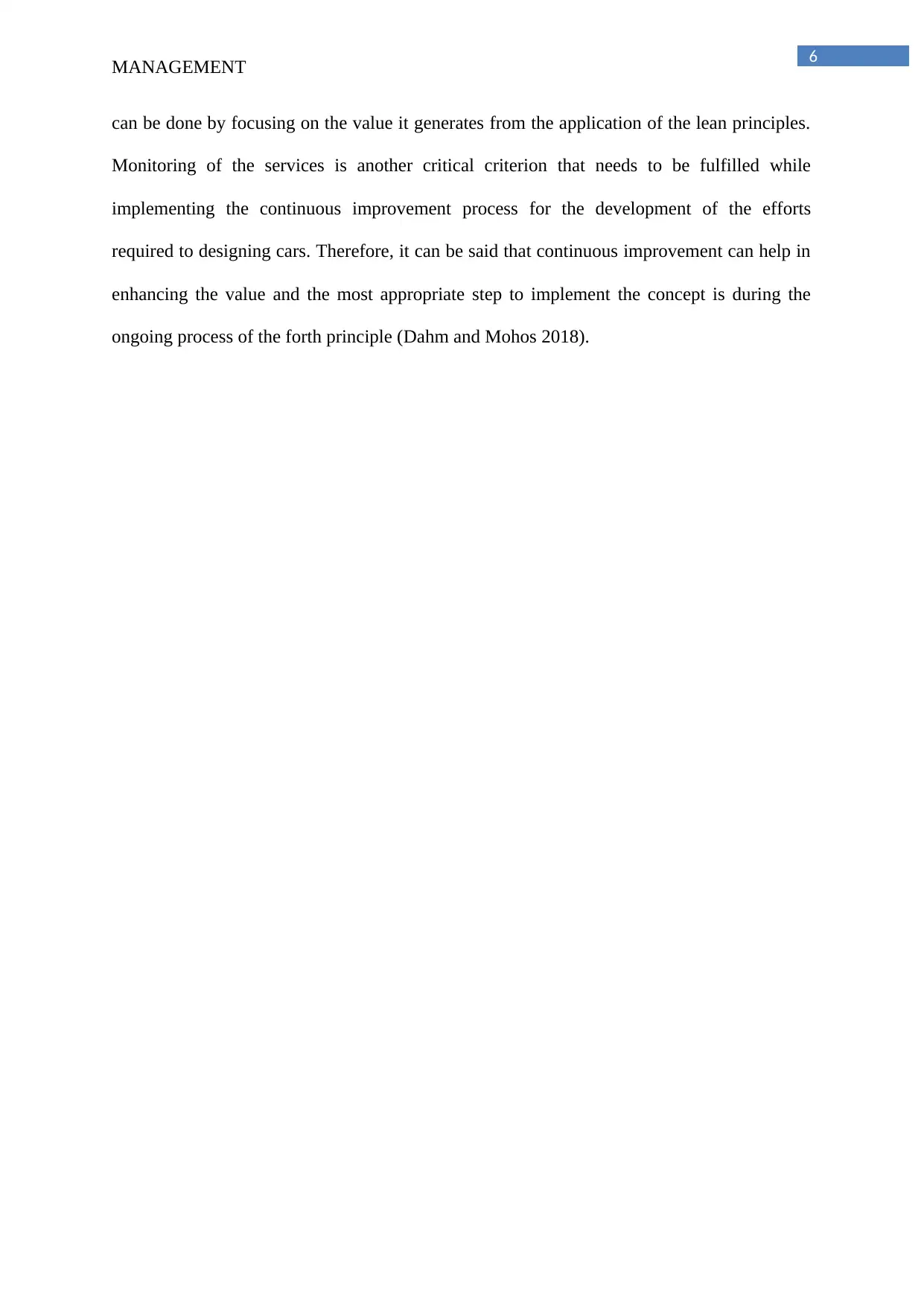
6
MANAGEMENT
can be done by focusing on the value it generates from the application of the lean principles.
Monitoring of the services is another critical criterion that needs to be fulfilled while
implementing the continuous improvement process for the development of the efforts
required to designing cars. Therefore, it can be said that continuous improvement can help in
enhancing the value and the most appropriate step to implement the concept is during the
ongoing process of the forth principle (Dahm and Mohos 2018).
MANAGEMENT
can be done by focusing on the value it generates from the application of the lean principles.
Monitoring of the services is another critical criterion that needs to be fulfilled while
implementing the continuous improvement process for the development of the efforts
required to designing cars. Therefore, it can be said that continuous improvement can help in
enhancing the value and the most appropriate step to implement the concept is during the
ongoing process of the forth principle (Dahm and Mohos 2018).
Paraphrase This Document
Need a fresh take? Get an instant paraphrase of this document with our AI Paraphraser
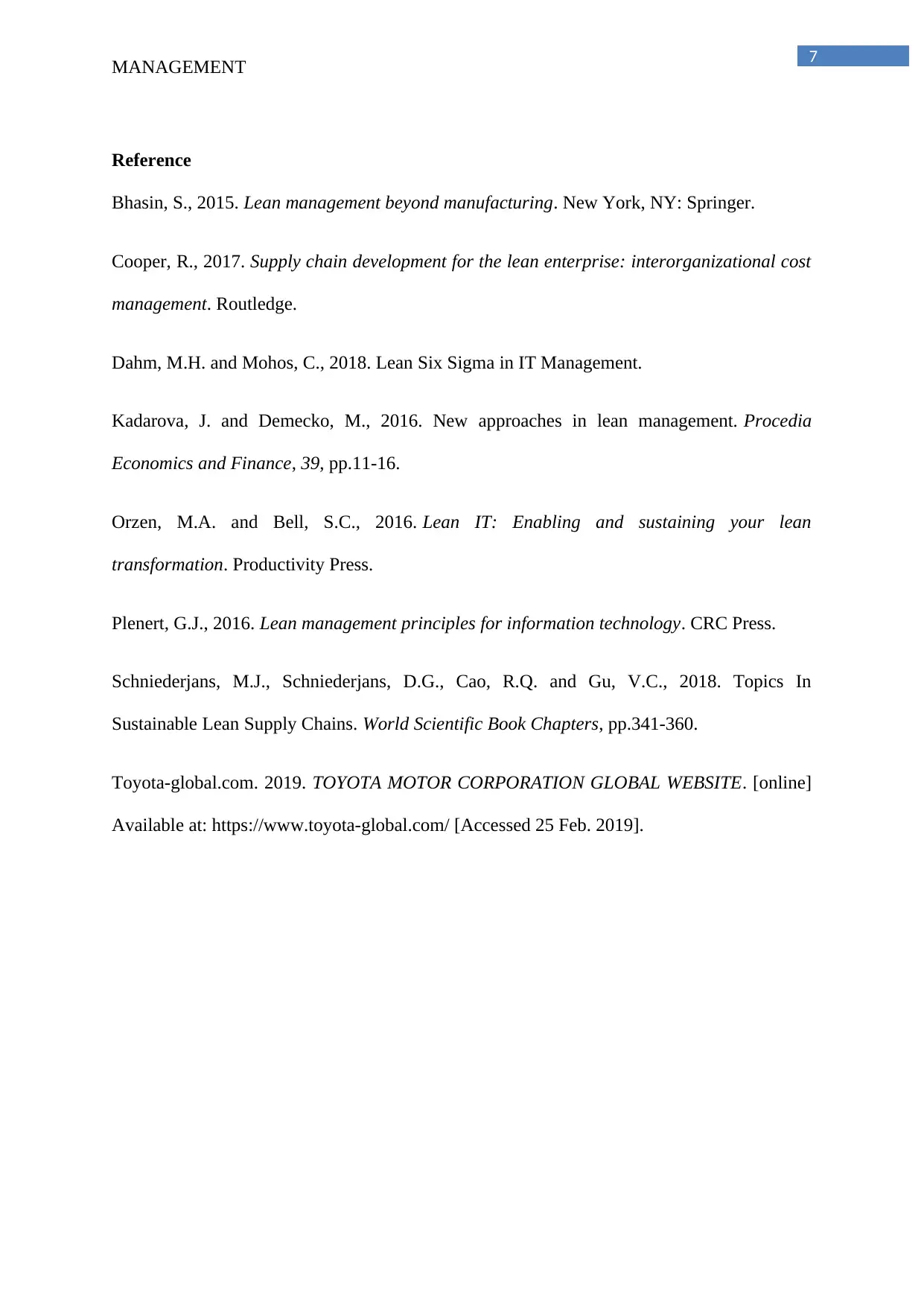
7
MANAGEMENT
Reference
Bhasin, S., 2015. Lean management beyond manufacturing. New York, NY: Springer.
Cooper, R., 2017. Supply chain development for the lean enterprise: interorganizational cost
management. Routledge.
Dahm, M.H. and Mohos, C., 2018. Lean Six Sigma in IT Management.
Kadarova, J. and Demecko, M., 2016. New approaches in lean management. Procedia
Economics and Finance, 39, pp.11-16.
Orzen, M.A. and Bell, S.C., 2016. Lean IT: Enabling and sustaining your lean
transformation. Productivity Press.
Plenert, G.J., 2016. Lean management principles for information technology. CRC Press.
Schniederjans, M.J., Schniederjans, D.G., Cao, R.Q. and Gu, V.C., 2018. Topics In
Sustainable Lean Supply Chains. World Scientific Book Chapters, pp.341-360.
Toyota-global.com. 2019. TOYOTA MOTOR CORPORATION GLOBAL WEBSITE. [online]
Available at: https://www.toyota-global.com/ [Accessed 25 Feb. 2019].
MANAGEMENT
Reference
Bhasin, S., 2015. Lean management beyond manufacturing. New York, NY: Springer.
Cooper, R., 2017. Supply chain development for the lean enterprise: interorganizational cost
management. Routledge.
Dahm, M.H. and Mohos, C., 2018. Lean Six Sigma in IT Management.
Kadarova, J. and Demecko, M., 2016. New approaches in lean management. Procedia
Economics and Finance, 39, pp.11-16.
Orzen, M.A. and Bell, S.C., 2016. Lean IT: Enabling and sustaining your lean
transformation. Productivity Press.
Plenert, G.J., 2016. Lean management principles for information technology. CRC Press.
Schniederjans, M.J., Schniederjans, D.G., Cao, R.Q. and Gu, V.C., 2018. Topics In
Sustainable Lean Supply Chains. World Scientific Book Chapters, pp.341-360.
Toyota-global.com. 2019. TOYOTA MOTOR CORPORATION GLOBAL WEBSITE. [online]
Available at: https://www.toyota-global.com/ [Accessed 25 Feb. 2019].
1 out of 8
Related Documents
Your All-in-One AI-Powered Toolkit for Academic Success.
+13062052269
info@desklib.com
Available 24*7 on WhatsApp / Email
![[object Object]](/_next/static/media/star-bottom.7253800d.svg)
Unlock your academic potential
Copyright © 2020–2025 A2Z Services. All Rights Reserved. Developed and managed by ZUCOL.





